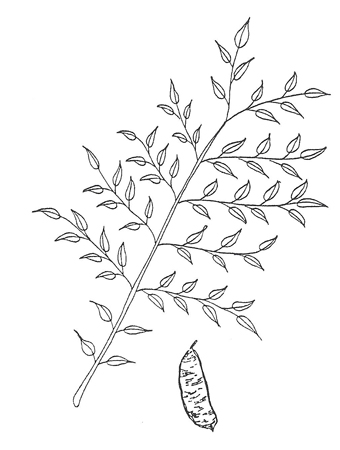Gymnocladus dioicus (jim-nok’-la-dus dy-o-ee’-kus)
Family: Fabaceae, Pea
Key Steps
- 1b – Alternate leaf arrangement — go to 18
- 18b – Leaf compound — go to 58
- 58b – More than 3 leaflets — go to 59
- 59a – Entire or very finely serrate leaflet margins — go to 60
- 60b – Thornless — go to 62
- 62b – Leaflets obviously pointed at tips — go to 63
- 63b – Bipinnately compound — Kentucky Coffeetree
- 62b – Leaflets obviously pointed at tips — go to 63
- 60b – Thornless — go to 62
- 59a – Entire or very finely serrate leaflet margins — go to 60
- 58b – More than 3 leaflets — go to 59
- 18b – Leaf compound — go to 58
Description
 Leaf: Each leaflet 2 to 2 1/2 inches long, broadest at base, pointed tip, smooth margin. 5-14 leaflets stalk, each with 3-7 pairs of leaflets. Entire leaf is 36 inches long by 24 inches wide. Dark green.
Leaf: Each leaflet 2 to 2 1/2 inches long, broadest at base, pointed tip, smooth margin. 5-14 leaflets stalk, each with 3-7 pairs of leaflets. Entire leaf is 36 inches long by 24 inches wide. Dark green.
Bud: Silky, sunken into stem. May be above one another. 2 dark brown scales visible. Terminal bud false.
Leaf Scar: Large, sunken into stem, heart-shaped. 3-5 bundle scars.
Stem: Very stout, contorted. Dense, short hairs when young. Reddish-brown. Orange lenticels.
Pith: Salmon-pine or reddish. Wide.
Flower: Loose, terminal panicle in May or June. Female: 12 inches long. Male: 4 inches long. Usually separate trees.
Fruit: Leathery, olive-brown pod, 5-10 inches long, persistent. Hard shell. Large round seeds.
Habit: Large, dense shade tree. Upright, narrow at base, wider at top. To 40 feet tall. Interesting branching pattern in winter.
Culture: Low water requirement once established. Full sun. Well drained soils. Prone to snow loading damage.




